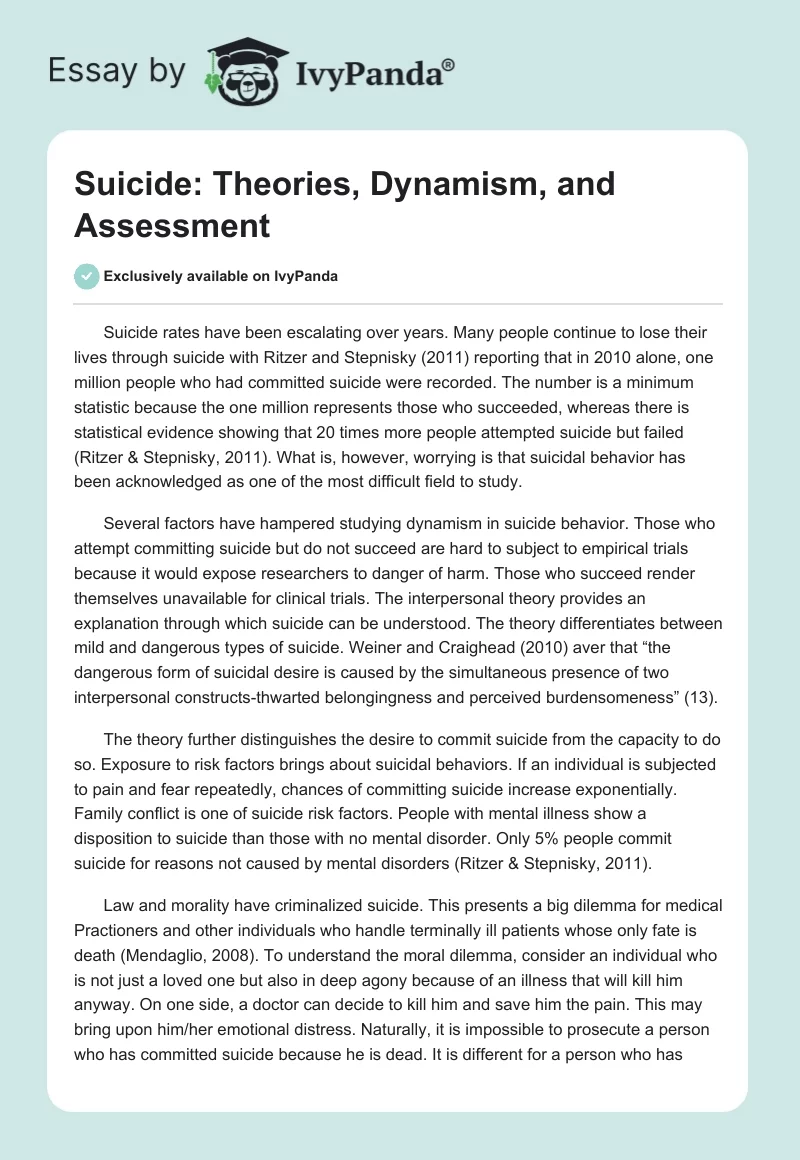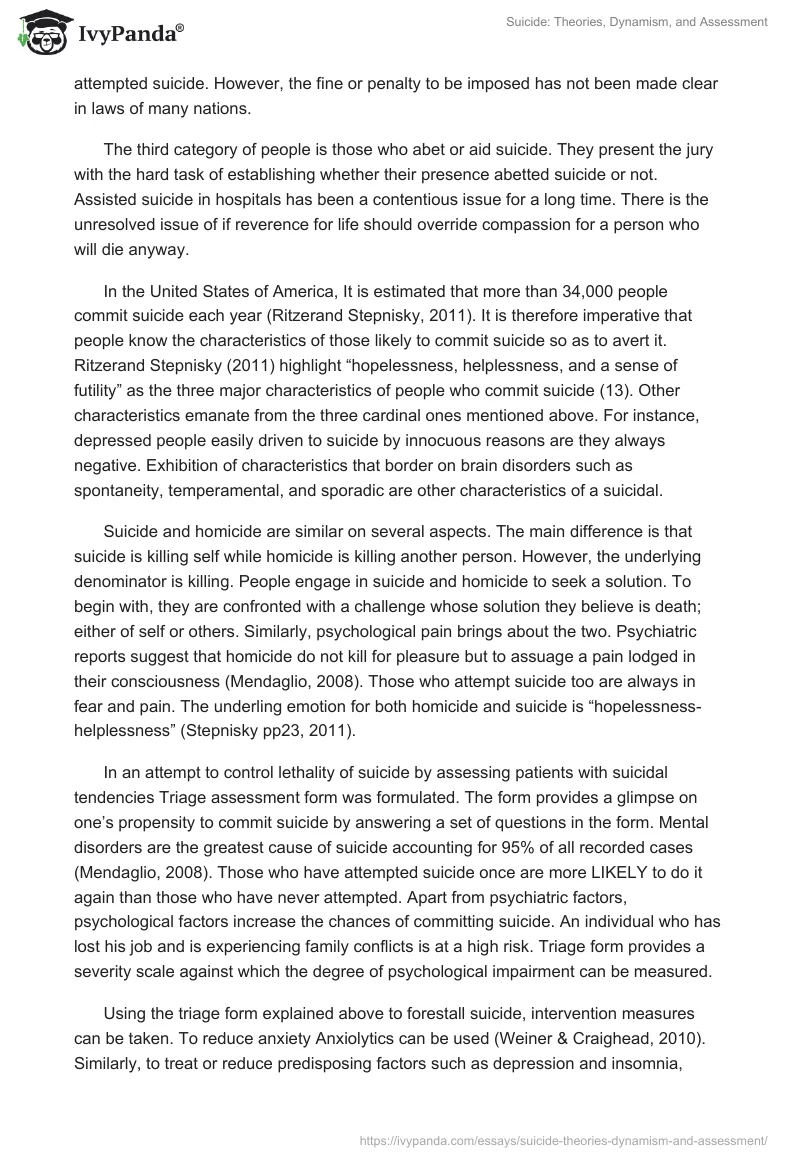Suicide rates have been escalating over years. Many people continue to lose their lives through suicide with Ritzer and Stepnisky (2011) reporting that in 2010 alone, one million people who had committed suicide were recorded. The number is a minimum statistic because the one million represents those who succeeded, whereas there is statistical evidence showing that 20 times more people attempted suicide but failed (Ritzer & Stepnisky, 2011). What is, however, worrying is that suicidal behavior has been acknowledged as one of the most difficult field to study.
Several factors have hampered studying dynamism in suicide behavior. Those who attempt committing suicide but do not succeed are hard to subject to empirical trials because it would expose researchers to danger of harm. Those who succeed render themselves unavailable for clinical trials. The interpersonal theory provides an explanation through which suicide can be understood. The theory differentiates between mild and dangerous types of suicide. Weiner and Craighead (2010) aver that “the dangerous form of suicidal desire is caused by the simultaneous presence of two interpersonal constructs-thwarted belongingness and perceived burdensomeness” (13).
The theory further distinguishes the desire to commit suicide from the capacity to do so. Exposure to risk factors brings about suicidal behaviors. If an individual is subjected to pain and fear repeatedly, chances of committing suicide increase exponentially. Family conflict is one of suicide risk factors. People with mental illness show a disposition to suicide than those with no mental disorder. Only 5% people commit suicide for reasons not caused by mental disorders (Ritzer & Stepnisky, 2011).
Law and morality have criminalized suicide. This presents a big dilemma for medical Practioners and other individuals who handle terminally ill patients whose only fate is death (Mendaglio, 2008). To understand the moral dilemma, consider an individual who is not just a loved one but also in deep agony because of an illness that will kill him anyway. On one side, a doctor can decide to kill him and save him the pain. This may bring upon him/her emotional distress. Naturally, it is impossible to prosecute a person who has committed suicide because he is dead. It is different for a person who has attempted suicide. However, the fine or penalty to be imposed has not been made clear in laws of many nations.
The third category of people is those who abet or aid suicide. They present the jury with the hard task of establishing whether their presence abetted suicide or not. Assisted suicide in hospitals has been a contentious issue for a long time. There is the unresolved issue of if reverence for life should override compassion for a person who will die anyway.
In the United States of America, It is estimated that more than 34,000 people commit suicide each year (Ritzerand Stepnisky, 2011). It is therefore imperative that people know the characteristics of those likely to commit suicide so as to avert it. Ritzerand Stepnisky (2011) highlight “hopelessness, helplessness, and a sense of futility” as the three major characteristics of people who commit suicide (13). Other characteristics emanate from the three cardinal ones mentioned above. For instance, depressed people easily driven to suicide by innocuous reasons are they always negative. Exhibition of characteristics that border on brain disorders such as spontaneity, temperamental, and sporadic are other characteristics of a suicidal.
Suicide and homicide are similar on several aspects. The main difference is that suicide is killing self while homicide is killing another person. However, the underlying denominator is killing. People engage in suicide and homicide to seek a solution. To begin with, they are confronted with a challenge whose solution they believe is death; either of self or others. Similarly, psychological pain brings about the two. Psychiatric reports suggest that homicide do not kill for pleasure but to assuage a pain lodged in their consciousness (Mendaglio, 2008). Those who attempt suicide too are always in fear and pain. The underling emotion for both homicide and suicide is “hopelessness-helplessness” (Stepnisky pp23, 2011).
In an attempt to control lethality of suicide by assessing patients with suicidal tendencies Triage assessment form was formulated. The form provides a glimpse on one’s propensity to commit suicide by answering a set of questions in the form. Mental disorders are the greatest cause of suicide accounting for 95% of all recorded cases (Mendaglio, 2008). Those who have attempted suicide once are more LIKELY to do it again than those who have never attempted. Apart from psychiatric factors, psychological factors increase the chances of committing suicide. An individual who has lost his job and is experiencing family conflicts is at a high risk. Triage form provides a severity scale against which the degree of psychological impairment can be measured.
Using the triage form explained above to forestall suicide, intervention measures can be taken. To reduce anxiety Anxiolytics can be used (Weiner & Craighead, 2010). Similarly, to treat or reduce predisposing factors such as depression and insomnia, other medications can be used. It is advisable for people to shun alcohol and other substance, more so those who show suicidal behaviors.
References
Mendaglio, S. (2008). Dabrowski’s theory of positive disintegration. Scottsdale, AZ: Great Potential Press.
Ritzer, G., & Stepnisky, J. (2011). The Wiley-Blackwell companion to major social theorists. Malden, MA: Wiley-Blackwell.
Weiner, I. B., & Craighead, W. E. (2010). The Corsini encyclopedia of psychology. Hoboken, N.J: Wiley.


